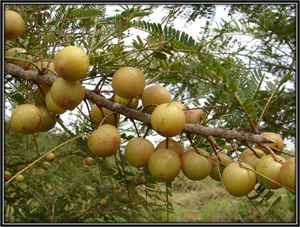PHYLLANTHUS EMBLICA
 Phyllanthus emblica is colloquially known as Amla. It is known as Amlaki in Sanskrit and Emblic Myrobalan or Indian Gooseberry in English.
Phyllanthus emblica is colloquially known as Amla. It is known as Amlaki in Sanskrit and Emblic Myrobalan or Indian Gooseberry in English.
The fruits of the Phyllanthus emblica are held in high esteem in Hindu Mythology. The fruit is associated with Kubera the lord of Wealth. This plant is used across the globe as an indigenous medicine. It is also one of the most important constituents of the famous Ayurvedic formulation called Triphala. This important ingredient provides vigor and strength to its user. There are majorly 2 kinds of Phyllanthus emblica and both are used in medicines.
This plant is found in all parts of India especially the southern part of the country up to an altitude of 1500 meters.
CHARACTERISTICS OF PHYLLANTHUS EMBLICA
The Phyllanthus emblica is a small or medium sized deciduous tree that has spreading branches. The trunk of the tree is crooked and has a smooth exfoliating bark. The digitate compound leaves are light green in color and are closely set near the branch. They are usually 10 to 15 mm long and 3 to 8 mm wide. The flowers of the Phyllanthus emblica are greenish yellow in color and the fruits are fleshy as well as shiny. The fruit also contains 3 loculi with carry 2 trigonous seeds each.
The leaves, seeds, root, bark, fruit and the flowers of the Phyllanthus emblica are used in medicinal formulations.
THERAPEUTIC POWERS OF THE HERB
The fruits of the Phyllanthus emblica are used mainly as a tonic. This tonic is prescribed for use usually during the winter season for relieving problems of constipation, urine discharge, memory as well as intelligence. The paste of the fruit powder is externally applied on the scalp and the skin as an alternate for soap. The leaves of the Phyllanthus emblica are used to relieve conjunctivitis as well as bronchitis. The powdered root bark is also used with honey as an external applicator on mouth ulcers.
The fruits of the Phyllanthus emblica are also used in food preparations. The plant is also useful in relieving problems blood dysentery, datura poisoning, mastitis, haematuria, ringworm, sprained hoof, abscess, diarrhea, coli bacillosis, indigestion, glossitis, lumbar fracture, burns as well as wounds.
The Ayurvedic properties of Phyllanthus emblica are as follows:
- Rasa: Five rasas (except lavana rasa)
- Vipaka: Madhur (sweet)
- Guna: Guru (heavy), ruksha (dry)
- Veerya: Shita (cold)
- Dosha: Pacifies tridosha
NUTRIENT COMPOSITION
The Phyllanthus emblica is rich in polyphenols like gallic acid, phyllemblic acid and ellgic acid. It also contains a large amount of ascorbic acid, cytokinins and fatty acids like behenic.
The pulp of the Phyllanthus emblica fruit constitutes around 90 percent of the entire fruit out of which 70.5 percent is moisture. The fruit also contains protein, calcium, magnesium, iron, phosphorus and reducing sugars.
CARE FOR AILMENTS
The Phyllanthus emblica contains the following properties:
- Hypolipidaemic property: The Phyllanthus emblica has lipid lowering as well as anti atherosclerotic actions.
- Antiviral Activity: The methanolic extract obtained from the fruits show significant inhibitory and anti viral activity.
- Hepatoprotective activity
- Hypoglycaemic activity
- Work against acute necrotizing pancreatitis
- Immunomodulatory activity
- Protective effect in cases of myocardial necrosis
- Anti dyspepsia activities
- High on anti oxidant levels
- Anti microbial activity
- Anti inflammatory and anti pyretic properties
SAFETY AND PRECAUTIONARY TIPS FOR USING THIS HERB
The fruits of the Phyllanthus emblica have shown no toxicity.
PLANET AYURVEDA PRODUCTS THAT USE THIS HERB
The products that contain this medicinal herb are:
We at Planet Ayurveda are constantly working on ways to provide our customers with natural managements. Our endeavor is to provide health using organic ingredients only. We do not test our products on animals. We are also proud to say that none of our products contain any preservatives.



